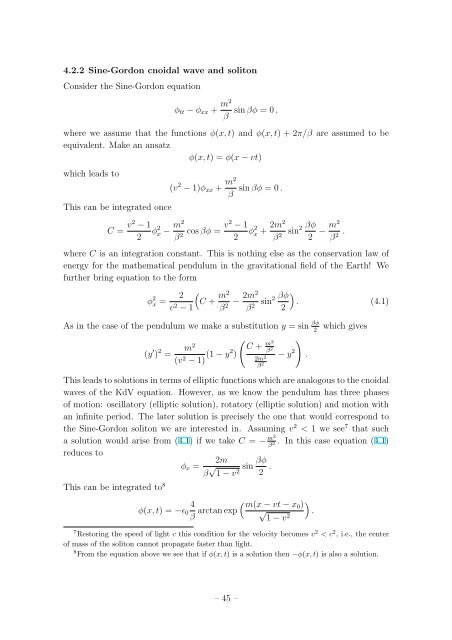Student Seminar: Classical and Quantum Integrable Systems
Student Seminar: Classical and Quantum Integrable Systems
Student Seminar: Classical and Quantum Integrable Systems
Create successful ePaper yourself
Turn your PDF publications into a flip-book with our unique Google optimized e-Paper software.
4.2.2 Sine-Gordon cnoidal wave <strong>and</strong> soliton<br />
Consider the Sine-Gordon equation<br />
φ tt − φ xx + m2<br />
β<br />
sin βφ = 0 ,<br />
where we assume that the functions φ(x, t) <strong>and</strong> φ(x, t) + 2π/β are assumed to be<br />
equivalent. Make an ansatz<br />
φ(x, t) = φ(x − vt)<br />
which leads to<br />
This can be integrated once<br />
C = v2 − 1<br />
φ 2 x − m2<br />
2<br />
(v 2 − 1)φ xx + m2<br />
β<br />
β cos βφ = v2 − 1<br />
2 2<br />
sin βφ = 0 .<br />
φ 2 x + 2m2<br />
β 2<br />
βφ<br />
sin2<br />
2 − m2<br />
β . 2<br />
where C is an integration constant. This is nothing else as the conservation law of<br />
energy for the mathematical pendulum in the gravitational field of the Earth! We<br />
further bring equation to the form<br />
φ 2 x = 2 (C + m2<br />
v 2 − 1 β − 2m2<br />
2 β 2<br />
βφ sin2 2<br />
As in the case of the pendulum we make a substitution y = sin βφ<br />
2<br />
(<br />
C +<br />
m 2<br />
(y ′ ) 2 = m2<br />
(v 2 − 1) (1 − y2 )<br />
)<br />
β 2<br />
− y 2 .<br />
2m 2<br />
β 2<br />
)<br />
. (4.1)<br />
which gives<br />
This leads to solutions in terms of elliptic functions which are analogous to the cnoidal<br />
waves of the KdV equation. However, as we know the pendulum has three phases<br />
of motion: oscillatory (elliptic solution), rotatory (elliptic solution) <strong>and</strong> motion with<br />
an infinite period. The later solution is precisely the one that would correspond to<br />
the Sine-Gordon soliton we are interested in. Assuming v 2 < 1 we see 7 that such<br />
a solution would arise from (4.1) if we take C = − m2 . In this case equation (4.1)<br />
β 2<br />
reduces to<br />
2m<br />
φ x =<br />
β √ βφ<br />
sin<br />
1 − v2 2 .<br />
This can be integrated to 8<br />
4<br />
( m(x − vt −<br />
φ(x, t) = −ɛ 0<br />
β arctan exp x0 )<br />
)<br />
√ .<br />
1 − v<br />
2<br />
7 Restoring the speed of light c this condition for the velocity becomes v 2 < c 2 , i.e., the center<br />
of mass of the soliton cannot propagate faster than light.<br />
8 From the equation above we see that if φ(x, t) is a solution then −φ(x, t) is also a solution.<br />
– 45 –

















